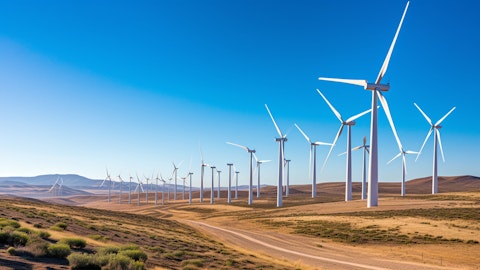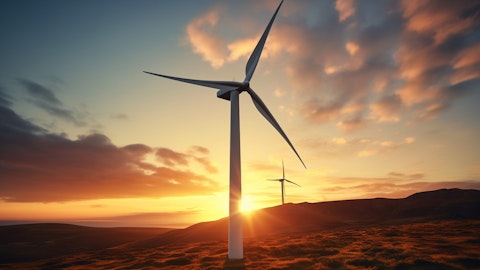General Electric Company (NYSE:GE) Q3 2023 Earnings Call Transcript October 24, 2023
General Electric Company beats earnings expectations. Reported EPS is $0.82, expectations were $0.56.
Operator: Good day, ladies and gentlemen, and welcome to General Electric Third Quarter 2023 Earnings Conference Call. At this time, all participants are in a listen-only mode. My name is Liz and I will be your conference coordinator today. [Operator Instructions]. As a reminder, this conference is being recorded. I would now like to turn the program over to your host for today’s conference, Steve Winoker, Vice President of Investor Relations. Please proceed.
Steven Winoker: Thanks, Liz. Welcome to GE’s third quarter 2023 earnings call. I’m joined by Chairman and CEO, Larry Culp; and CFO, Rahul Ghai. Some of the statements we’re making are forward-looking and based on our best view of the world and our businesses as we see them today. As described in our SEC filings and on our Web site, those elements may change as the world changes. Over to Larry.

A technician monitoring the production of electriciy from a renewable energy source. Editorial photo for a financial news article. 8k. –ar 16:9
Larry Culp: Steve, thank you and good morning, everyone. Before we start, I want to reiterate that the GE team stands firmly with our employees, customers, and all those impacted by the brutal Hamas attacks on Israel in the subsequent war. Our priority has been the safety of GE employees in the region. We’re doing everything possible to support them and their families. Last week, GE announced $0.5 million contribution to help with the humanitarian efforts for the many people in Israel, Gaza and the surrounding areas impacted by these horrific events. Terrorism has no place in our society. And like so many, I’m devastated by the loss of lives, violence and suffering of innocent people. Turning to the quarter, GE delivered a very strong performance and we’re raising full year guidance again.
GE Aerospace continues to experience rapid growth, driven by robust demand and solid execution largely in commercial engines and services, another significant quarter for the team. Our fleet of 41,000 commercial engines and 26,000 rotorcraft and combat engines continues to expand as we work to define the future of flight. Today, we’re navigating a still challenging supply chain environment to deliver for and support our customers. Year-to-date, commercial engine deliveries are up 30%. Across GE and Safran’s MRO shops this quarter, we’ve approved LEAP quick turn shop visits over 30% year-over-year and sequentially. Tomorrow we’re building our backlog and sales pipeline during unprecedented industry growth. Recently, Air Canada ordered 36 GEnx-1B engines plus four spares building on GEnx’s rich history as the fastest selling high thrust engine with over 50 million flight hours.
For the future, we’re investing in R&D and developing next generation technologies. For example, we’re advancing full system testing for our hybrid electric systems at our electric power center in Ohio. We’re also collaborating with industry partners in NASA on an eco demonstrator program to measure sustainable aviation fuel impact on the environment, particularly high-altitude emissions. And our growth opportunities extend beyond commercial. In defense, we’re pleased the U.S. Army has accepted the first two T901 flight test engines for the future attack reconnaissance aircraft prototypes. The T901 will also upgrade the U.S. Army’s Apache and Blackhawk helicopters, providing 50% more power, reduce lifecycle costs and lower fuel consumption.
And we’ve been selected for development work on the cockpit voice and flight data recorder systems for the future Long-Range Assault Aircraft program. Next generation programs like these demonstrate how GE’s rotorcraft programs enable the military and our allies to take on more challenging missions today and in the future. And we’re pleased to see Congress recognizing this important work by including funding for advanced engine development like the XA 100 in both the House and Senate fiscal year ’24 defense appropriation bills. However, even with these strong results, we’re far from satisfied. Through our lean transformation, we’re making real progress, improving flow and eliminating waste. For example, our team in Pune, India has increased output of LEAP high pressure turbine manifolds by 3x.
But we need to do more, as do our suppliers, given the pace of demand for both aftermarket services and new engine deliveries. There are pockets of improvement now, material input increased double digit sequentially supporting spare parts delivery, which was up significantly year-over-year. We’re working within our own plants and in partnership with our suppliers to deliver sequential improvements and output and turnaround times day-by-day, week-by-week. Over to GE Vernova where performance is strengthening pre-spin at both renewable energy and power. Customers continue to invest in the energy transition, driving meaningful demand for our products and services. Grid and now Onshore Wind were both profitable this quarter and we expect improved performance from here.
Grid customers are increasing their infrastructure investments globally to connect renewables and improve reliability. Year-to-date, orders remain strong and more than 3x revenue and with higher margins, which will support profitable growth through the decade. We’ve also increased selectivity, streamline cost and rationalized our industrial footprint, tracking towards full year profitability at grid. I really liked the way the grid team is using lean to drive this turnaround and to deliver profitable growth. For example, across power transmissions, 14 sites globally, we’ve reduced lead time by roughly 15% year-to-date, and we’re targeting a 20% reduction by year end. Now with onshore. Our strategy to focus on fewer markets, pivoting more toward North America, where GE Vernova is the market leader is working.
And we’re relying more on our workhorse products, now representing 70% of equipment volume this quarter. These shifts are translating to 700 basis points of higher margins in backlog this year. We’re still driving cost out, fewer layers, reducing headcount and empowering leaders closest to the operators. Finally, we’re improving fleet reliability. We’re now halfway through our enhancement program in the field and expect to be roughly 60% complete by year end. As expected, Offshore Wind remains difficult this year, with losses of roughly $1 billion in 2023. Next year we expect offshore will have similar losses, but substantially improved cash performance. So it’s a tough $6 billion backlog that we’re working our way through, which we expect to largely complete over the next two or three years.
Meanwhile, we’re making operational progress with rising availability on the 800 installed megawatts of our 6 megawatt platform. Electricity is now being produced at Dogger Bank, and we recently had the installation of our first Haliade-X turbans at Vineyard Wind. Looking forward, we’ve expanded Vic Abate’s role to CEO of the entire wind business to leverage our progress in onshore and offshore. We’re taking a similarly disciplined approach to writing new business, like we’ve done over at gas, onshore and grid, with increased rigor on pricing terms, geographic exposure, and other risks. All-in-all, given powers continued strength, and with our two largest businesses in renewables grid and now onshore delivering, plus our plan for offshore, we’re highly confident and successfully spinning off GE Vernova early in the second quarter.
Across GE, I’m pleased with how we’re operating as a simpler, more focused business at both GE Aerospace and GE Vernova. Another strong quarter, but plenty more to do. My thanks go out to the team for their dedication and commitment to serving our customers. It’s been nearly two years since we announced our intention to create three independent investment grade industry leaders. And now we’re closing in on the final step. Today, we announced plans to spin off GE Vernova and launch GE Aerospace in the beginning of the second quarter of 2024. Both will be listed on the New York Stock Exchange with GE Vernova as GEV and GE Aerospace carrying forward under GE. We made some important hires and promotions to ensure we have the best teams leading these businesses forward.
At GE Aerospace, we’ve completed the functional leadership team, naming our heads of corporate affairs, human resources, legal and treasury with experienced leaders from inside and outside GE. At GE Vernova, we added seasoned public company CFO, Ken Parks. As I mentioned a moment ago, Vic Abate is now CEO of the wind business. We’ve also further simplified and strengthened our balance sheet by redeeming the remainder of our preferred equity and selling a portion of our AerCap shares for $2.7 billion of proceeds. Our balance sheet is well positioned to support the launch of two investment grade companies. And we’re approaching some key spin milestones. GE Vernova will file a confidential Form 10 shortly, with the initial public filing expected in the first quarter.
Soon we’ll announce each company’s Board of Directors in an early March GE Vernova and GE Aerospace plan to hold investor days. Building on our success, GE Healthcare, we’re exactly where we want to be at the end of October for both GE Aerospace and GE Vernova. Now over to Rahul for more detail on our results.
Rahul Ghai: Thank you, Larry. Turning to Slide 4, I’ll speak to the quarter on an organic basis. Overall, we delivered meaningful growth across our headline metrics. Orders were up double digits, with services up 15% driven by commercial aerospace and equipment up 22% with growth in all segments. Revenue increased 18% benefiting from strong market demand, improved execution and pricing. Aerospace was led by commercial services and engines. Renewables was led by grid and offshore and power from heavy duty gas turbines and aero derivatives. All segments contributed to adjusted margin expansion of 760 basis points. This included the absence of last year’s wind-related charges and the benefits of volume, price, net of inflation and productivity and continued investments in growth.
Adjusted EPS was $0.82, up almost $1.00 year-over-year. Excluding last year’s wind-related charges, adjusted margin still expanded 400 basis points and EPS was up $0.59, or more than triple what we delivered last year. We generated $1.7 billion of free cash flow, up roughly $1 billion largely driven by earnings. Working capital was a positive $400 million flow, driven by disciplined receivables management while inventory remained inflated due to continued supply chain challenges. Year-to-date, free cash flow was $2.2 billion, up $2.5 billion, reflecting higher earnings, reduced working capital and improved linearity. Switching to corporate. Results improved significantly due to energy financial services gain on sale from investments and higher interest income.
Also, as we prepare to reduce costs, as we prepare to become standalone businesses, for the year, we now expect expenses in the $500 million range. At insurance, we completed our annual review of liability cash flow assumptions under the new accounting standard. This resulted in an immaterial adjustment to earnings indicating claims experience is consistent with our models. Given GE Aerospace’s strength and GE Vernova’s improvement, we are raising full year guidance and now expecting revenue growth of low teens, up from low double digits, adjusted EPS of $2.55 to $2.65, up $0.40 at the midpoint, largely from improvement in operating profit that we now expect to be in a range of $5.2 billion to $5.5 billion and free cash flow of $4.7 billion to $5.1 billion, up $550 million at the midpoint largely from higher earnings and lower AD&A outflow.
Now spending a moment on each business, starting with GE Aerospace, demand remains robust with GE and CFM departures growing mid teens year-over-year. Orders were up 34% with strong growth in both equipment and services. Revenue was up 25%, led by commercial engines and services up 29% and defense growing 8%. Profit grew over $400 million or more than 30%. Notably, margins expanded 120 basis points to reach 20.4%. Higher services, volume and pricing net of inflation more than offset investments and adverse mix. In our commercial business, services strength continued to drive profit with services revenue up 31% from volume, pricing and heavy work scopes. External spare parts were up more than 35% and internal shop visits grew 2% with supply chain constraints impacting growth.
Commercial engines revenue grew 23% with LEAP deliveries up 12% year-over-year. We are now planning for a 40% to 45% increase in LEAP deliveries this year, down from our 50% target at the beginning of the year. We now expect OE revenue to grow low to mid 20s and services revenue to be up mid to high 20s for the year. In defense, book-to-bill remains strong this quarter, again, greater than 1 and 1.3x year-to-date, highlighting the strong demand environment and quality of our franchisees. Revenue grew high single digits with strength in services and Edison works offsetting lower unit deliveries. Based on GE Aerospace’s year-to-date strength, we are raising revenue growth to the low 20s and profit to be about $6 billion, up roughly $1.2 billion year-over-year, with free cash flow growth trending better than prior expectations.
Moving to GE Vernova. Lean, along with better underwriting, selectivity, and productivity, is delivering stronger results we mentioned earlier at grid and, now, onshore. At renewables, orders grew again, up 3% this quarter and up more than 80% year-to-date to nearly $18 billion. Grid orders increased over 50% this quarter. And while primarily in equipment business today, we are starting to grow grid services that was up double digits this quarter. In onshore, North American equipment orders for the quarter were up nearly 40% and, year-to-date, are up more than 2.5x over prior year. The IRA continues to be transformative, establishing multiyear U.S. demand visibility for future growth. Internationally, onshore orders were down meaningfully, but at better margins consistent with our strategy of greater selectivity.
Revenue grew 14%. Grid increased with double-digit growth at each business. At onshore, North American equipment growth was more than offset by lower repower and international equipment. At offshore, revenue more than tripled year-over-year and grew sequentially with higher nacelle output. Profit improved from our turnaround efforts. Excluding last year’s elevated reserve, renewables margin still expanded roughly 600 basis points, driven by continued price and productivity. Onshore and grid margins expanded due to price and productivity, and grid margins also benefited from additional volume. For the year, renewables now expects low double-digit revenue growth. We are maintaining the guidance for significantly better year-over-year profit with onshore and grid improvement more than offsetting the offshore pressure.
Turning to power. We delivered solid year-over-year revenue growth and margin expansion with seasonally lower outages. Equipment orders grew slightly as higher heavy-duty gas turbines more than offset lower aeroderivative units. Services declined slightly as high single-digit growth in gas transactional services was offset by aeroderivative and steam services. For the year, we still expect total services orders to grow low single digits. Revenue grew 9%, largely on price and higher scope on heavy-duty gas turbine and aeroderivative equipment. Services grew again, up low single digits. Profit grew roughly 60% with 200 basis points of margin expansion, driven by higher volume, pricing, and productivity, which more than offset inflation pressure.
Year-to-date, power orders have grown low single digits, revenue mid-single digits and margins have expanded over 100 basis points. This was led by services, including higher gas utilization, up low single digits, benefiting from a continued coal to gas switching. We also shipped nine HA units this year and now have more than 47 gigawatts of installed capacity, continuing to extend our HA services billings to $1 billion by mid 2020s. In the fourth quarter, power is well positioned for sequential profit growth from seasonally higher services volume. For the year, power continues to expect low single-digit revenue growth with better year-over-year profit. Taken together, for GE Vernova, we are now expecting high single-digit revenue growth and profit improvement of over $800 million year-over-year at the midpoint.
We are raising the low end of our profit guidance driven by both renewables and power and now expect negative $300 million to negative $100 million of operating profit, as we continue to expect flat to slightly improved free cash flow. Overall, we are really encouraged proving with grid and onshore that we can deliver better results. This, combined with power’s continued strong performance, will drive meaningful profit and cash flow improvement at GE Vernova next year. And with that, let me turn it back to Larry.
Larry Culp: Rahul, thank you. To summarize, GE Aerospace grew rapidly again, and GE Vernova renewables improved sequentially, and power continued to perform well. Overall, a very strong quarter for GE, one that gives us confidence and thus allows us to raise our full year guide. More importantly, we’re poised to launch two innovative global service-focused industry leaders in less than six months. I’m proud of our team and even more excited for what lies ahead. Steve, let’s go to Q&A.
Steven Winoker: Before we open the line, I’d ask everyone in the queue to consider your fellow analysts and ask one question so we can get to as many people as possible. Liz, please open the line.
See also 30 Best Paying Jobs With High School Degrees and 10 Most Effective Methods of Birth Control and Biggest Brands In This Space.
Q&A Session
Follow General Electric Co (NYSE:GE)
Follow General Electric Co (NYSE:GE)
Operator: [Operator Instructions]. Our first question comes from the line of Scott Deuschle with Deutsche Bank.
Scott Deuschle: Good morning.
Larry Culp: Good morning.
Scott Deuschle: Rahul, is the lower LEAP delivery guide a function of softer narrow-body deliveries at the airframers or is this more related to challenges to your own production ramp-up? And then how should we think about the impact to 2024? Thank you.
Rahul Ghai: Let me start and Larry, I’m sure can add here. It’s primarily a function of our own supply chain challenges that we are having internally. As we look at our supply chain environment, while we are working extremely hard, we are seeing an improvement in total material inflow. The supplier delinquencies still remain high. Actually, we’re up sequentially about 25% from 2Q to 3Q. So that is impacting our output on the other end. And for next year, we’re still expecting 40% to 45% improvement in LEAP deliveries from where we end this year.
Operator: Our next question comes from the line of Nigel Coe with Wolfe Research.
Nigel Coe: Thanks. Good morning.
Larry Culp: Good morning, Nigel.
Nigel Coe: Just one question. Hi, guys. So I think Larry, you mentioned offshore losses of about 1 billion this year. I think you mentioned similar next year. Is there still a pathway to breakeven to profit for Vernova — sorry, for renewables next year?
Larry Culp: I would say, Nigel, that we’re really pleased overall with renewables. Again, with onshore turning profitable in the quarter, with grid now profitable two quarters in a row with the prospect of being profitable, I think for the full year, that’s really I think sets us up very well. But offshore will be difficult. That’s what’s behind those underlying numbers for this year and for next. I do think we’re making the operational progress that we talked about, both the 6 megawatts and the new projects with Dogger Bank and with Vineyard. But it is a problematic financial profile. We’ll work our way through the $6 billion backlog over the next couple of years as we indicated. I think with the progress and the momentum we’ve got in grid and with onshore, with power as well, we’ve got — we should deliver sequential improvement in profitability from here.
But offshore will be difficult. I think what we’re encouraged by though is that the application of what we’ve done in the other businesses around selectivity is really relevant here. We know the industry is ready for a reset. You’ve seen that in the comments from a number of folks in New York State over the last couple of weeks as well. So we think we can make a much better business with offshore wind, but we’re staring at some challenges that we need to address here in the fourth quarter and in ’24 for sure.
Operator: Our next question comes from the line of Seth Seifman with JPMorgan.
Seth Seifman: Good morning, everyone.
Rahul Ghai: Good morning.
Larry Culp: Good morning.
Seth Seifman: So I wonder maybe, Rahul, if you could talk about the aftermarket expectations. You said mid to high 20s this year. Maybe kind of how that’s changed or if it’s changed between internal shop visits and spares and then kind of how we interpret the big sequential growth in spares during the quarter? Was that — is that a new sustainable level? Is that — was that driven by pre-buy ahead of a price increase? Is it mostly — is it driven by the price increase itself? Maybe just to level set expectations on aftermarket.
Rahul Ghai: Yes. So let’s start with the second part of the question first, Seth, and we’ll go back to where you started. So on the spare part revenue, spare part revenue was up about 35% or more than 35% this quarter. I would say three main things; volume, pricing, and increased work scope. Volume growth continues from mid teens departures in the quarter and then stronger departure growth in the first half, which leads to volume in the third quarter. And also keep in mind that it’s less of a challenge to kind of ship spare parts versus completing a shop visit or an engine, so that also helps with shipping spare parts when the volume is strong. The second part I would say going back to pricing, we implemented a high single digit price increase this quarter.
Now we had pulled forward the price increase from the fourth quarter to the third quarter, so we got a couple of months of incremental price in the quarter. And then combine that with what Larry has been pushing for the last 12 to 18 months is just very, very strong pricing discipline. So it’s not just about implementing a price increase, it’s also about managing the implementation of that price increase. So I think we’re doing a better job of that. The last thing I would say is the work scopes have been heavier, both on the narrow-bodies and on the wide-bodies. So wide-bodies, they’re coming back to kind of second shop visits. Narrow-bodies is primarily a phenomena of customers kind of trying to constrain spending in challenging times, especially in China last year.
So now as they are a little bit more cash with departures growing, they are — the work scopes are increasing. So I would say those are the three main levers of higher spare parts growth in the quarter, which was more than 35%. I would not attribute any of that to pre-CLP buy. Now as you look forward to the first part of your question between spare parts growth and shop visits, spare parts I would say are strong. We expect a mid-20s growth in the fourth quarter which will be in line with where the departures are. Shop visits I think for the year, we’re in that kind of low teens to mid teens category. I think that’s what we are thinking right now given how challenging supply chain has been and shop visits were up a couple of points in the third quarter.
So we think for the year, we’re kind of in the low teens to mid teens range.
Operator: Our next question comes from the line of Julian Mitchell with Barclays.
Julian Mitchell: Hi. Good morning.
Larry Culp: Good morning, Julian.





